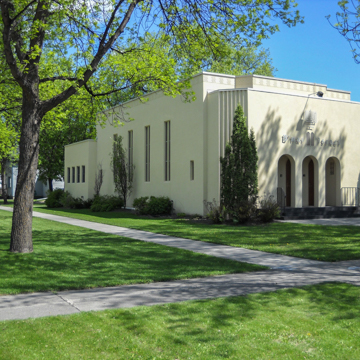Constructed during the Great Depression and dedicated four years after the death of long-standing rabbi Benjamin Papermaster, B’nai Israel Synagogue is notable for its strong expression of Streamline Moderne motifs. The DeRemer firm is known for advancing such avant-garde styles regionally. The synagogue reflects the growing involvement of Samuel Teel DeRemer in his father’s practice. This synagogue, for which construction funds were raised during the Depression years, replaced an earlier synagogue in Grand Forks’ nearby Jewish neighborhood, which was essentially erased by redevelopment in the 1960s. The small rectangular building has a triple-arched entrance portico and is decorated with vertical fluting and zigzag patterning.
Though somewhat distant from the synagogue, Montefiore Cemetery (N. Columbia Road and Gateway Drive), named for British philanthropist Sir Moses Montefiore, is significant as a distinctive landscape that expresses the burial traditions of Grand Forks’ Jewish citizens. The cemetery includes a high proportion of graves of first-generation Jewish immigrants, especially those of families relocating to Grand Forks from fledgling agricultural colonies on the urban frontier.















